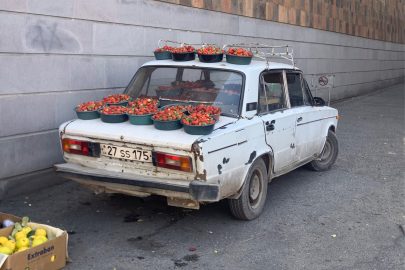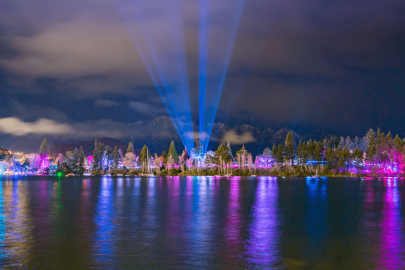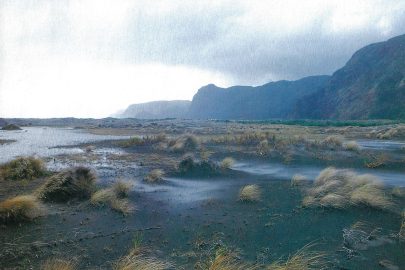Nov 13, 2015 Travel
Greg Bruce travelled to Atlanta courtesy of Coca-Cola. He really wanted to. We didn’t feel we could say no.
This article was first published in the October issue of Metro. Illustration: David Follett.
Ted Ryan’s office high in the Coca-Cola building has an incredible view across Atlanta and beyond, to the green Georgia horizon, but the view he cares about much more, and the reason for his existence, is in the basement.
There, behind a couple of ugly warehouse double doors off a nondescript hallway, lie the Coca-Cola archives: a rich, exhaustive, detailed accounting of everything Coke-related that the company has ever been able get its hands on. There’s a hell of a lot of Coca-Cola bottles and glasses, and drawer after drawer of photos and papers. If you wandered in there by accident, you’d wander straight back out, assuming you’d made a boring mistake.
We had spent some minutes in there, looking around, discussing the importance and difficulties of keeping an archive like this. “Show and tell,” Ryan then said, suddenly, gesturing at a painting that had been sitting on the wall alongside where we had been standing. “Norman Rockwell. We estimate this between 15 and 25 million dollars.”
“This?” I asked, incredulous. Stripped of its context and without any interpretation, it was a picture of a kid in a hat on a tree stump with a Coke, on a barren wall at the end of a dull room full of boxes. We had been standing next to the painting for a while, without any fanfare. I didn’t mean to sound so surprised.
“It’s a Norman Rockwell,” Ryan said, his voice rising defensively. “He’s America’s greatest illustrator, Coke is America’s greatest brand. A Rockwell sold for almost $40 million a couple of years ago, another one sold for $28 million last year. This is one of his better-known images.”
In between the Rockwell and the hospital-style double doors at the other end of the room were aisles and aisles of crap: valuable crap, invaluable crap. One of the few things in the Coca-Cola archives more valuable than the Rockwell is the original written version of the secret formula and that is supposedly not in the archives but in a theatrically unlikely “vault” at World of Coca-Cola in downtown Atlanta, the tourist attraction that is effectively a repurposing of the Coke archives in a fancy building for paying guests.
Ryan pulled items seemingly at random from the shelves: “This was the Google Maps of its day, he said, holding up a strange Coke-sponsored device that lines up your location, destination and best route.
Next he pulled Tiffany-style lamps, genuine Tiffany lamps, tip trays, a folder full of photos of strange scenes from New Zealand.
“Where’s my cricket paddle?” he said at one point, pulling from a shelf a Coke-sponsored bat signed by the Australian team when they were good.
“I hope I’m not boring you,” he said. “This is like asking to see pictures of my kids.”
“Photo opportunity,” he said, handing me a torch from the London Olympic Games of 2012, and taking my camera. “Ever held an Olympic torch before?” I hadn’t.
The importance of these objects to the company is not as things in themselves but as ways of connecting with people. Ryan sees this place not as a series of objects but as a trove of stories: every item a story, every story a building block of the Coca-Cola brand.
“Hey, Jamal,” he said to archive manager Jamal Booker. “What do you think about corporate storytelling? Is it important?”
“It’s who we are,” Jamal said.
Sometime around 2009 or 2010 — I really don’t remember — I had just broken up with my fiancée, whom I had been with for seven years. I felt down about it for a good few weeks, for a number of reasons. I just didn’t feel bright and shiny about life.
I’m not going to say that the moment I’m about to recount brought me out of that funk, but there I was slumped in front of television in my one-room flat one night when I saw an ad featuring a cavalcade of spectacularly attractive young people in togs being blasted out of the top of an inflatable Coke bottle off some incredible beach.
“Hello, is this thing on?” The lyrics started, quirkily, intriguingly. “Is anybody listening?” Yes, I was. “A brand-new day has begun.”
That was a sentiment I could dig, and it was also a truth. It might not have been profound, but profundity was not what I needed at that point in my life. The images were so joyfully ridiculous as to be beyond ridicule. They short-circuited my cynicism and tapped directly into something more elemental, beyond cynicism. This is something Coke’s best advertising has always done.
The music rose and erupted into its joyful chorus as if it were a spectacularly attractive young person being blasted out of an inflatable Coke bottle at an improbably beautiful beach.
“Come on and lift me up, it’s a brand-new day / open up a little happiness today / so I can be someone new.”
How I felt those lyrics and the relentless bounce of that music. It was the beginning of summer and anything was possible! Life wasn’t for lying around helplessly, moping and worrying: it was for happiness, for joy. I wanted to go find my attractive people, my propulsive inflatable Coke bottle, and blast out into the world.
Not that I did that, at least not right away, but life is not all grand-scale wish-fulfilment, is it? It’s a series of moments in which we feel good or we don’t. That was a moment, right there, in which I felt one, then the other, and Coke was there, and I have never forgotten it.
Across town from Coke’s headquarters, at Atlanta’s High Museum of Art, Ted Ryan and the museum’s curator, Julia Forbes, discussed the two priceless Andy Warhol paintings of Coke bottles on the wall before them, part of the exhibition The Coca-Cola Bottle: An American Icon at 100, which celebrates the impact on visual culture of the iconic contour bottle over the century since it was created.
How I felt those lyrics and the relentless bounce of that music. It was the beginning of summer and anything was possible! Life wasn’t for lying around helplessly… it was for happiness, for joy.
Warhol painted the two within a year of each other, as a sort of experiment, and he tested them on friends and visitors. The one on the left featured smudges and drips of paint — the clear hand of the artist. Warhol described it as more lyrical. The one on the right was crisp, clean and bold.
“One particularly famous moment he describes in his book,” Forbes said, “is an art critic and colleague saying to him, ‘The one on the left: crap, burn it. The one on the right, that’s your direction, go that way, that’s the answer.’”
Ryan said: “He opens up his book Popism with that story and finishes that chapter by saying, ‘That was a very important day for me.’ At the High Museum of Art is the first time those two paintings have been reunited.”
“His whole pop-art style starts with this,” Forbes said, the excitement in her voice undimmed by the fact she has probably told this story over and over for what must feel like forever, during the several months of this exhibition.
“This is before the Campbell’s soup cans and the ketchup and the Brillo boxes,” she continued. “Here’s a moment where an artist really transforms art history and at the moment he’s doing that, the Coca-Cola bottle is what he’s using for his inspiration.”
What grabbed Warhol about Coke? Why was that the brand with which he decided to reinvent the way the world looked at art? Was it happiness? Joy? Optimism?
“What’s great about this country,” reads the Warhol quote on the wall at the High Museum, “is that America started the tradition where the richest consumers buy essentially the same things as the poorest. You can be watching TV and see Coca-Cola, and you know that the President drinks Coke, Liz Taylor drinks Coke, and just think, you can drink Coke, too.”
What grabbed Warhol and attracted him to Coke was its ability to connect us. It seems an extravagant thing to say that a drink has this power but Coke is not just a drink and you know it.
In 1994, I was on a bus returning from seventh-form camp. I can’t remember being more thirsty before or since. I had spent most of the week mildly dehydrated, repulsed by the fetid, tepid cordial left to warm in plastic tanks outside the food hall every day.
We had spent the early afternoon on the beach and it was hot on the bus. All I had been able to think about for some time was getting home and drinking a Coke. It was the purest fantasy: it would be a moment of joy, a thirst quenched, a black sparkle of happiness.
My friend Jeremy, sitting next to me on the bus, told me that a girl, whose name I can’t remember but it may have been Claire, who was reasonably new to our school, who was, I think, Australian and who was so beautiful that just to think about her made me forget how to talk, had a bottle of Coke.
He knew her, and because he knew I could never have even said hello to her, he somehow brokered a deal for me to have a swig of her Coke. As I raised the bottle to my lips, I felt unadulterated gratitude: to Claire, to Coke, to Jeremy. Sated and delighted, I handed the bottle back to Jeremy, who handed it back to Claire.
I idly wondered if this interaction meant it was possible that Claire and I would go out together — even though no girl had ever wanted that in the past, and none would want it for some time in the future. My hold on reality had been unlocked by joy: Open up, open up, open happiness!
“Your friend doesn’t have any manners,” she said to Jeremy after I forgot to say thank you. That was the last time I remember having anything to do with Claire. I have never forgotten the satisfaction of that Coke or the dissatisfaction of its aftermath.
On the wall next to the Norman Rockwell painting in the Coke archives are a series of paintings by Haddon Sundblom, the man whose illustrations for Coke starting in the 1930s defined the modern image of Santa Claus.
“Those have hung at the Louvre, they’ve been in the Royal Ontario, the V&A, they’ve been at the Chicago Art Institute,” Ryan said. “They’ve been in world-class museums around the world. There are over 40 of the paintings that Sundblom did. I insure them for $400,000, but none of them has ever been sold, so I don’t know.”
Coke’s head of design, James Sommerville, is a rock’n’roll-type guy who dresses in a lot of black and a bit of leather. He spends a lot of his time in the archives, looking for inspiration. When he first arrived at Coke two years ago, he went more or less directly to the archives and pulled vintage artwork from the files to be reimagined by designers around the world more or less however they wanted, while retaining the company colours and some vague spirit of the original.
That crazy, crazy artwork, now hash-tagged “mashupcoke” and disseminated digitally around the world — and currently on billboards and in television ads in New Zealand — speaks of Coke as a brand that knows that its relevance in the future will be built on its past.
“You can create a new proposition, a design proposition that is rooted in something we’ve already done in the past,” Sommerville says. “I once heard it said that there are only eight scripts in Hollywood: they’re just told in different ways. You can only reinvent the wheel so many times. And I believe the same. The stories in the packaging and the things we create, we may have told them before, but we’re telling them in a new way.”
Through its past and our pasts, and their entwining, Coke knows the nature of its hold on us. It knows the most important thing in the world is to maintain that. We have so many memories of Coke. It’s Coke’s job to sell us stories that make sure we never forget that those memories are of happiness and connection, great taste, uplift and refreshment.
At world of Coca-Cola, there is a full-sized theatre that just plays one film. It’s six minutes long and called Moments of Happiness. It’s so disgracefully mawkish and emotionally exploitive that I’m not ashamed to say it made me cry.
Through its past and our pasts, and their entwining, Coke knows the nature of its hold on us. It knows the most important thing in the world is to maintain that.
There is nothing radical or new in this film. It plays a very loud, incredibly upbeat soundtrack featuring the refrain “I’m on top of the world”, and is made up of several narratives, intercut and each rising to its own climax: a soldier recording a video message for his family from Afghanistan at the start of the film surprises them by turning up at the end. A cute young couple going on a hot-air-balloon ride at the start of the film get engaged high above the city at the end. Some kids trying to make an impossible basketball shot at the start make the impossible shot at the end.
It throws you back to the great Coke campaigns of the past: the hilltop ad with its attractive multicultural young people sharing a song of hope in the countryside, or the beach ads full of insanely happy young people, or the ads with people just kissing joyfully in the rain.
But more importantly, it throws you back to the happy moments of your life, those times of intense emotional connection — I got engaged once, and it felt just like that! — and it speaks of how Coke knows that, and how Coke somehow is that.
Brands are stories. Companies try to shape those stories, but the most powerful stories are the ones we tell ourselves.
There is much rich and valuable history in the Coke archives. There were whole rows of artefacts that Ted Ryan never even ventured down with me: so many stories left untold. I’m sure they were interesting enough, but when I think about Coke in the future, as when I thought about it in the past, my first thought won’t be of the time I accidentally insulted an iconic Norman Rockwell painting in front of its owner or got to see first-hand the two paintings that birthed pop art, together for the first time. The first things I’m always going to remember are drinking a bittersweet Coke on a bus as an awkward teenager and feeling embarrassingly uplifted by a happy ad at a difficult time in my life.
In 1985, the Coca-Cola Company almost destroyed itself by changing the recipe for Coke, based on focus-group results that showed people preferred the new taste. The backlash was so severe that, 79 days later, they changed it back.
Nobody was under any illusion that the company’s climb-down had anything to do with what was in the bottle. New Coke was better, at least by the only objective measure that seemed to matter.
“That was when we realised we didn’t own our brand,” Ryan says. “Here’s a great story: A lady wrote [to Coke president] Donald Keough, complaining. He said, ‘When was the last time you had a Coke?’ She said, ‘Twenty years ago, but that’s not the point. You took away my memories.’”





